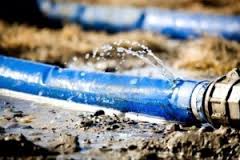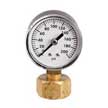|
| |
How
to check water leakage in your Plumbing lines
Main
Article page |
Beauty articles
|
Health page |
Computers|
Diseases |
Education |
Entertainment |
Family
Business |Fitness|
Fruits and Vegetables
|
Jobs |
General |
Personality|
Technology
|
Tourism |
Sports
House Plans |
House Loans |
Real Estate|
Vaasthu
Shastra|
Construction Tips
Engineering page
| Interior Design |
Property Buying Tips |
Renting Tips |
Journals /
Magazines

The water supply system or a
wastewater system in a house or other building may have a leak in any of
numerous locations, causing dripping out or spillage of the water.
There can be numerous causes of leaks. Leaks can occur from the outset even
during construction or initial manufacture/assembly of fluid systems. Pipes,
valves, fittings, or other components may be improperly joined or welded
together. Components with threads may be improperly screwed together. Leaks can
be caused by damage
Often leaks are the result of deterioration of materials from wear or aging,
such as rusting or other corrosion or decomposition of elastomers or similar
polymer materials used as gaskets or other seals. For example, wearing out of
faucet washers causes water to leak at the faucets
There are several methods for leak testing, depending on the situation.
Sometimes leakage of fluid may make a sound which can be detected.
Plumbers often test for leaks after working on a water or other fluid system. A
vessel or system is sometimes pressure tested by filling with air and the
pressure monitored to see if it drops, indicating a leak. A very commonly used
test after new construction or repair is a hydrostatic test, sometimes called a
pressure test. In a hydrostatic test, a system is pressurized with water to look
for a drop in pressure or to see where it leaks out. Helium testing may be done
to detect for any very small leakage such as when testing certain diaphragm or
bellows valves, which are made to be practically leak-proof. Helium and hydrogen
have very small molecules which can go through very small leaks.
 How to
check for hidden leaks By Greg Chick: Leaks waste water and cause serious
damage, especially where you can't see them. Many leaks can also be of a small
enough quantity that you would never notice them on your water bill. Small leaks
can become big ones (big expensive ones!). In the photo to the right, the copper
pipe failed from the inside, corroded completely through, and formed a leak, the
water eroding the copper to form an even larger hole. How to
check for hidden leaks By Greg Chick: Leaks waste water and cause serious
damage, especially where you can't see them. Many leaks can also be of a small
enough quantity that you would never notice them on your water bill. Small leaks
can become big ones (big expensive ones!). In the photo to the right, the copper
pipe failed from the inside, corroded completely through, and formed a leak, the
water eroding the copper to form an even larger hole.
 Greg
demonstrates a very easy way to check for leaks by using an inexpensive pressure
gauge (less than $10 at the home center). In the video you'll see what it looks
like when there is a leak and also when there is not one. Greg
demonstrates a very easy way to check for leaks by using an inexpensive pressure
gauge (less than $10 at the home center). In the video you'll see what it looks
like when there is a leak and also when there is not one.
To do this, a gauge is attached to a hose bibb on the building
side of the shut-off valve. Then, the valve is closed to trap pressure in the
system. If there are no leaks the system will hold the pressure over night. In
this video, we demonstrate the leak rate with a slowly dripping faucet (though
the leak could easily be a hidden one).
 An
important aspect for this type of test to work is that the shut-off valve makes
a good solid seal. If you have a ball valve like this one, it's sure to meet
that requirement. These valves turn 90° to shut off and often have a lever
handle as shown. An
important aspect for this type of test to work is that the shut-off valve makes
a good solid seal. If you have a ball valve like this one, it's sure to meet
that requirement. These valves turn 90° to shut off and often have a lever
handle as shown.
However, if your water shut off is a gate valve (as shown to the
left), then a tight seal is not guaranteed. Test results that appear to show "no
leaks" may actually not be the case. If the valve leaks close to the amount that
the inside pipes are leaking then you will not be able to detect a leak in this
case.
|
Time to complete |
up to 30 min, but you may want the test to run
overnight. |
|
Materials |
water pressure gauge, channel locks or other
pliers |
|
Costs |
about $10 (for the pressure gauge.) |
|
Skill level |
easy |
( Courtesy:
www.diyplumbingadvice.com )
Read more about water leakage
Articles:
-
Construction: What is
GRP or fibreglass ?
-
Interior design : What is
MDF-Medium Density Fiberboard. ?
-
Construction: What is epoxy
based paint?
-
Guidelines and tips: To find a reliable Builder or
Contractor
-
Guidelines & tips
before you start house construction
-
What is top-up housing loan ?
-
Home improvement tips:
Wallpaper for interiors
-
Benefits of rainwater
harvesting in homes
-
Tips & guidelines: Electricity Saving at home
-
Coming Up With Landscaping Ideas
-
How to set out a building on site
-
Interior design: The Rebirth of Wallpaper
-
What
is
Green Building ?
-
What is Domestic biogas plant ?
-
Why home insurance is very important in India?
-
How To Install a Home Wind Turbine
to get energy
-
How to Install Electric Wiring
-
Significance of Home Plumbing
-
Should I buy or rent? A simple calculation
-
Easy Landscaping Tips for Beginners
-
Construction technique:
Rapidwall technology
-
Buying a flat? Don't get carried away by the sample
-
30-storey hotel built in just 15
days
-
Is it worth buying an old
house
-
House plans, home plans, plans, residential plans
-
House Loans, home loans, where to get housing loan
-
How do loans work, the basic concepts of loans
-
Construction Tips, construction guide lines,
-
house rental tips, rental tips, renting properties
-
Real Estate
-
Flooring
-
What is Reverse Mortgage
-
Guidelines to purchase residential properties
-
Lotus-shaped 91 feet prayer hall in kerala
-
What is Interior Design, interior desings, resources
-
Interior Design Colleges
-
Interior Design- Bed Rooms
-
Interior Design- Bath Rooms
-
Kitchen Designs, kitchens
-
Modern Architectural Design Softwares
-
Landscaping Designs landscape architectures
-
-
|
|
| |
|




 How to
check for hidden leaks By Greg Chick: Leaks waste water and cause serious
damage, especially where you can't see them. Many leaks can also be of a small
enough quantity that you would never notice them on your water bill. Small leaks
can become big ones (big expensive ones!). In the photo to the right, the copper
pipe failed from the inside, corroded completely through, and formed a leak, the
water eroding the copper to form an even larger hole.
How to
check for hidden leaks By Greg Chick: Leaks waste water and cause serious
damage, especially where you can't see them. Many leaks can also be of a small
enough quantity that you would never notice them on your water bill. Small leaks
can become big ones (big expensive ones!). In the photo to the right, the copper
pipe failed from the inside, corroded completely through, and formed a leak, the
water eroding the copper to form an even larger hole. Greg
demonstrates a very easy way to check for leaks by using an inexpensive pressure
gauge (less than $10 at the home center). In the video you'll see what it looks
like when there is a leak and also when there is not one.
Greg
demonstrates a very easy way to check for leaks by using an inexpensive pressure
gauge (less than $10 at the home center). In the video you'll see what it looks
like when there is a leak and also when there is not one.
 An
important aspect for this type of test to work is that the shut-off valve makes
a good solid seal. If you have a ball valve like this one, it's sure to meet
that requirement. These valves turn 90° to shut off and often have a lever
handle as shown.
An
important aspect for this type of test to work is that the shut-off valve makes
a good solid seal. If you have a ball valve like this one, it's sure to meet
that requirement. These valves turn 90° to shut off and often have a lever
handle as shown.